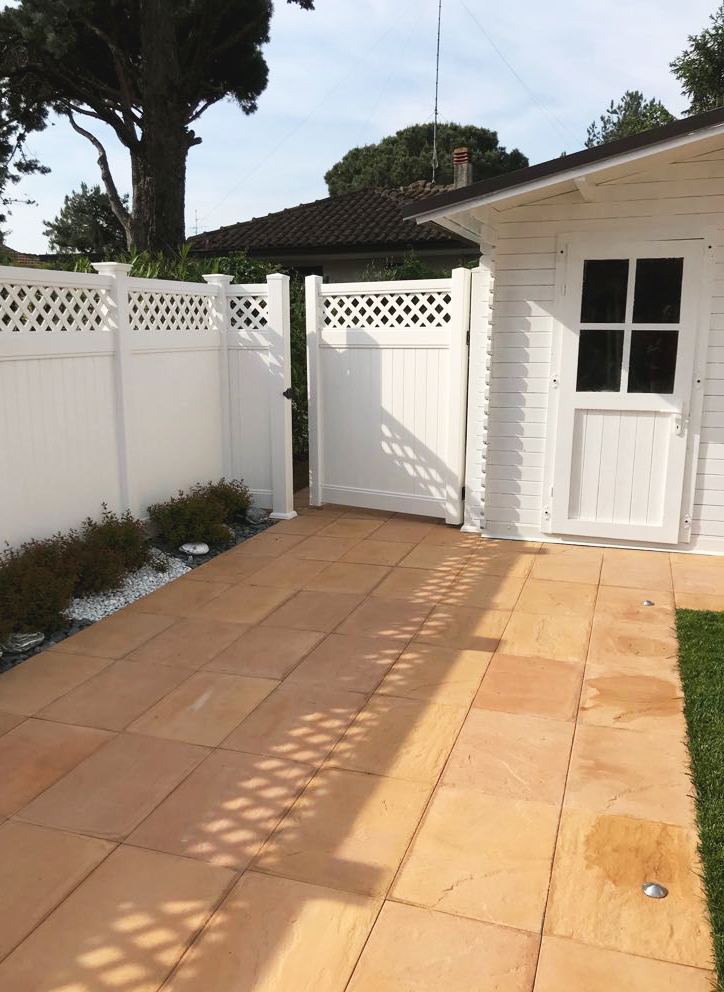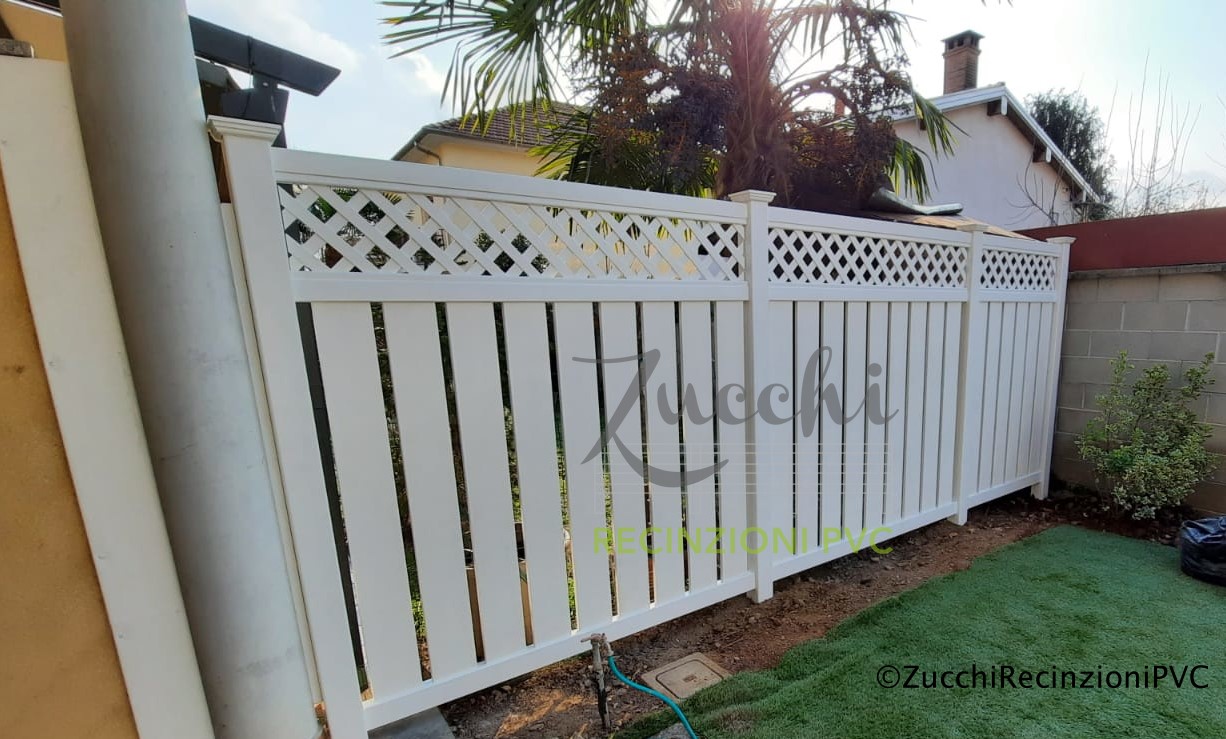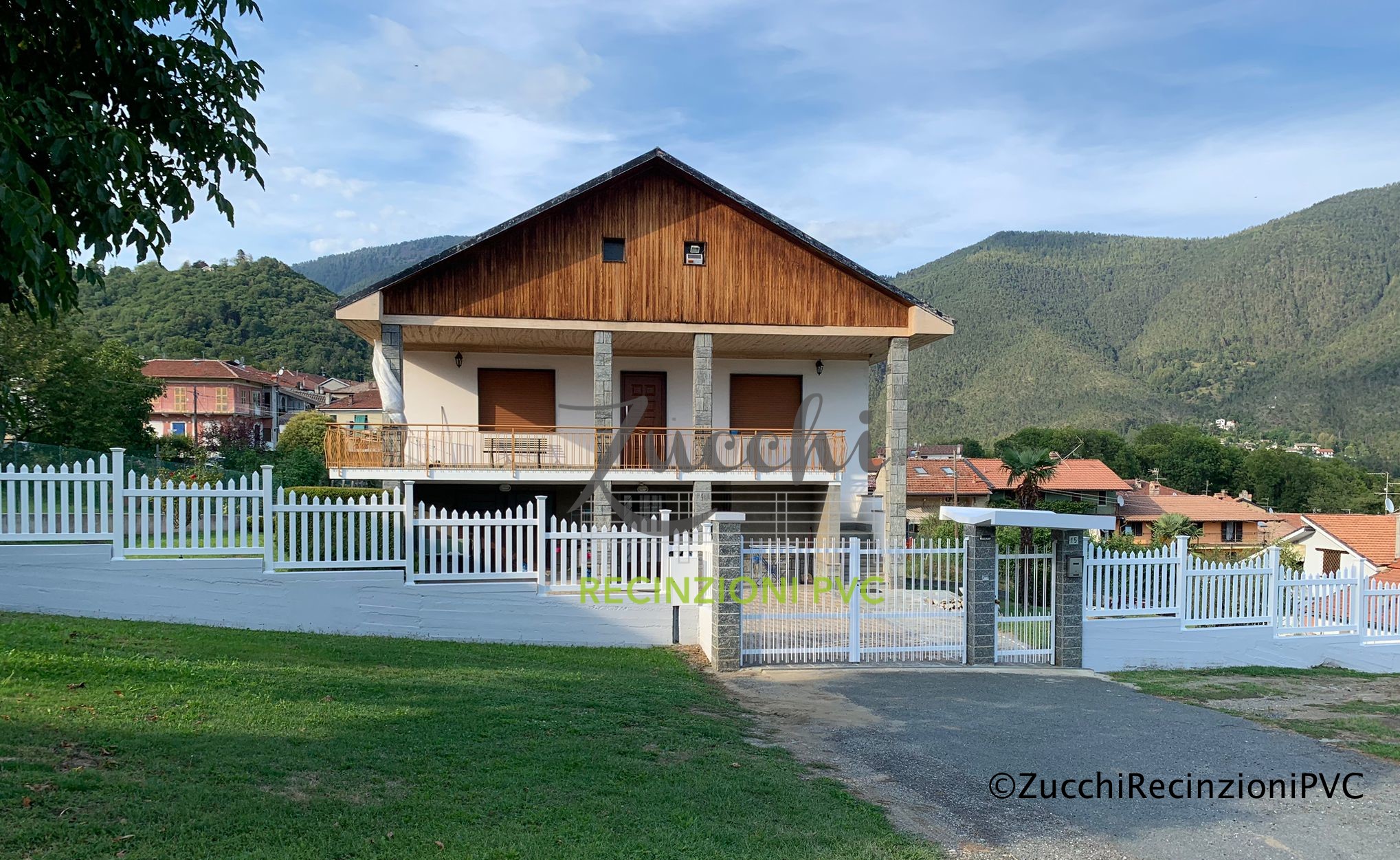How to know if PVC is the right choice.
Where you place it makes the difference: analyzing the ground.
Before even thinking about the color or style of the PVC wall, ask yourself: where exactly will it be installed?
The ground on which you’ll place the structure can turn a textbook job into a small nightmare to fix.
PVC is a lightweight and easy-to-handle material, but that doesn’t mean you can just stick it anywhere without thinking.
If you’re on sandy soil, for example, you might face stability issues if you don’t use well-designed anchoring systems.
And don’t forget the slope. Even a slight unevenness can cause unpleasant surprises over time if you don’t compensate for it properly at the start.
Sometimes it’s enough to dig a few centimeters deeper, or use a modular leveling base to make everything more stable and secure.
Clay soil, on the other hand, is a whole different story: in summer it’s as hard as concrete, but in winter it swells and shifts.
In these cases, it’s best to make a small concrete base or place the modules on light footings to avoid future settling.
Then there’s the perfect ground, compact and well-draining, that lets you install everything in half a day with a smile. When you find it… be thankful!
But since the world isn’t always ideal, it’s better to learn to recognize the signs of “problematic” ground before you start digging.
Residential or rural area? Change your approach.
The geographic area where you work also plays a very important role, and not just for aesthetics or client requests.
In an urban residential area, for example, you will likely have to deal with municipal restrictions, condominium regulations, and prying eyes.
In these areas, PVC dividing walls have an advantage because they are discreet, clean, and often installable without invasive permits.
But be careful: always check local regulations. Some municipalities require height limits or setback distances even for lightweight structures.
In rural areas, however, the situation changes. Here the PVC wall can serve to delimit vegetable gardens, relaxation areas, or animal spaces.
The good thing is that you can often work with more freedom, but you still need to consider practical factors like the presence of animals, strong wind, or tall grass.
Watch out for traffic too. If the wall is exposed to a road, especially near a busy passage, greater stability is needed.
In those cases, it’s worth using heavier modules at the base or reinforcing with invisible brackets that increase stability.
Finally, listen to the client: they often tell you very useful things. If they say “the sun hits here all day,” take note immediately.
It will help you choose the color, the type of fastening, and in explaining the advantages of PVC over other materials.
Sun, rain, frost: the climate is your ally (or enemy).
The climate may seem like a minor detail, but I assure you it can completely change your approach to installation.
Blazing sun all year round? PVC tends to expand slightly, so it’s important to leave a few millimeters between modules.
Constant rain and humidity? Choose models with drainage systems or joints that don’t trap water between panels.
Also, use stainless steel or galvanized screws and anchors: they last longer and save you unpleasant surprises after months.
If you work in areas with harsh winters and frequent freezes, consider the effect of ice on the ground and material expansion.
In this case, it’s better to avoid anchoring directly into the ground if it’s too soft: prefer concrete bases or modules resting on the surface.
In windy areas – and there are many in Italy – don’t underestimate the sail effect of taller, lighter panels.
PVC is lightweight, sure, but with good design you can make it more stable than many poorly built masonry walls.
Finally, consider sun exposure. A wall facing south will be more prone to fading if it’s not UV-treated.
Fortunately, many PVC models today have anti-yellowing treatments, but it’s good to know this to answer clients’ questions.
The client who wants everything, immediately and without dust.
You recognize them right away: they come with confused ideas, maybe they’ve already seen something online, and want “something quick.”
This type of client has neither the time nor the desire to deal with dusty construction sites, bulky equipment, or endless waits for materials.
Often, these are families with children or young couples who want to finish everything before the next backyard barbecue.
PVC is the perfect choice here because you can promise a quick, clean installation without the need for heavy equipment.
The best part? When you tell them, they look at you with teary eyes. “Really, no excavators or cement mixers are needed to do the job?”
You can reply confidently: “No, and in a day at most, everything is ready, without a single grain of cement in sight.”
Another advantage is the lightness. If the client has a narrow driveway or complicated access, transporting PVC modules is a piece of cake.
In situations where moving traditional materials would be impossible or dangerous, PVC installs without problems.
In short, if the client is impatient, mindful of household chaos, and wants to see results immediately, the PVC wall is your ace up the sleeve.
The client who wants to spend little but make a good impression.
Here’s a really interesting category: those who say “I don’t want to spend too much, but it has to look good and last.”
This is where all the magic of PVC comes into play: pleasant aesthetics, low costs, and practically zero maintenance.
This type of client is often very informed, has already watched tutorials and read blogs, but needs confirmation from a professional.
They are the classic profile who compares everything: prices, materials, timelines, durability, and even the final visual effect.
Your job here is to make them understand that a PVC wall is not “a cheap second-rate solution,” quite the opposite.
With the right modules, you can create elegant, clean, and modern partitions that truly enhance the exterior of the house without spending a fortune.
Also, it’s perfect for those who want to avoid yearly maintenance. No painting, no mold, no cracks to fix.
Just a wipe with a sponge now and then, and the wall always looks new, even after several seasons.
If your client is budget-conscious but has a taste for quality, look no further: PVC is the right answer.
With a good presentation and maybe some “before and after” photos, you’ll win them over in ten minutes.
The senior (or lazy) client who wants eternal peace.
Then there’s the client who doesn’t want any more worries: they’ve already done a thousand jobs at home and now just want definitive solutions.
Maybe they’re an elderly person, or simply someone tired of the complications and surprises that construction sites bring.
This client doesn’t want to replace a brick in two years, nor see cracks or peeling every season change.
They want to install today and forget about it tomorrow, enjoying their garden or terrace in peace, without any stress.
With PVC you can guarantee them all this. It’s durable, doesn’t rust, chip, or crack from frost.
And since it’s modular, if a piece gets damaged for some reason, you can replace it in five minutes without touching the rest.
Here your reassuring tone is key: “There’s no need to check it every season, and if something happens, it’s fixed quickly.”
They’ll see you as the craftsman of the future, the one who offers easy and lasting solutions, not complications disguised as tradition.
Another plus? Safety. If the wall is meant to protect the garden or screen the entrance, PVC does its job.
Without sharp edges or dangerous parts, it’s also safer for children, dogs, and people with mobility difficulties.
This client won’t ask you a thousand technical questions, but will want to know just one thing: “Can I sleep peacefully for the next twenty years?”
And the answer is yes, if you choose the right products and do a job done to perfection.
In summary: PVC is perfect for (almost) everyone.
Every client has different needs, but if there’s one thing that unites them, it’s the desire for simple, fast, and reliable solutions.
PVC meets the most common expectations well: quick installation, low maintenance, good aesthetic appeal, and affordable costs.
Whether you’re talking to young families, budget-conscious clients, or elderly people, PVC always has a strength to offer.
It’s your job to recognize the type of client and propose the right wall at the right time, with the right tone.
And trust me: when they see the final result, they often say something priceless…
“Why didn’t I do this sooner?”
PVC and existing structures: a couple that (almost) always works.
If there’s one thing that makes PVC so loved by installers, it’s how versatile it is next to other existing structures.
Let’s be clear: often you have to integrate a new wall into a setting where you can’t touch almost anything.
The client already has a porphyry driveway, wooden flooring, an automatic gate installed six months ago… and what do you do?
With PVC, the great thing is that you can adapt without compromising anything, because it’s a flexible, lightweight, and easily workable material.
You can place it next to an iron railing, a mesh fence, or an existing wall, without mismatches or structural problems.
Often, a good initial assessment and some smart mounting accessories are enough to make you look like a true professional.
And then there’s the aesthetic factor: PVC walls come in neutral finishes, oak wood effect, matte white, and other variants.
This makes them compatible even with modern fences, garden sheds, pergolas, gazebos, and the whole outdoor world.
When PVC meets concrete, iron, or wood.
Each material has its own character, and when you work with them, you know they don’t always get along with each other.
Concrete is solid but cold, iron is strong but can rust, wood is warm but requires constant care.
PVC, on the other hand, adapts to everyone and doesn’t throw tantrums. It’s a bit like that coworker who gets along with everyone on the construction site.
For example, if you need to place it next to an old concrete wall, you can use angle brackets to create visual and functional continuity.
Are you working on a metal structure? No problem: galvanized steel supports compatible with PVC modules exist.
You can fix the wall directly to an iron base without the risk of cracks or structural stress over time.
And if the client has a wooden fence? Even better! Wood-effect PVC creates a harmonious transition between the two surfaces.
Plus, unlike wood, it doesn’t fade, swell, or attract insects: a perfect combo with no surprises.
It’s also worth saying that working with PVC in mixed contexts saves you time because it’s easy to cut and lightweight.
No special equipment needed, no need to reinforce existing bases, and you can make last-minute adjustments.
Practical tricks to join PVC to other elements
Here come into play all the little tricks that make the difference between a “done” job and a “well done” job.
When you connect a PVC wall to a metal fence, for example, watch out for the difference in thermal expansion of the materials.
PVC expands with heat, so it’s good practice to leave small expansion gaps between fixed contact points.
This prevents the panels from swelling or bending unpleasantly in summer.
Another useful trick is using rubber pads, seals, or flexible profiles to soften the contact between different materials.
These accessories are inexpensive but increase the durability of the entire system and prevent annoying creaks or micro-cracks.
When working near an existing concrete base, take accurate measurements and use expansion anchors with wide washers.
PVC doesn’t require invasive fastenings, but a good anchoring base prevents it from moving due to wind or accidental impacts.
Finally, remember that you can always play with the height: if the neighbor has a low fence, PVC can become a partial cover.
Or, on the contrary, you can extend an old low wall to screen the view with tall and lightweight PVC modules.
It’s not always love: when PVC isn’t the right choice
PVC is great, we know that well. It’s lightweight, practical, quick to install, and goes with almost everything.
But precisely because you’re a professional, it’s important to recognize when it’s better to say no and opt for other materials.
It often happens that the client insists on PVC at all costs because they saw it online or on a neighbor’s terrace.
But you, as a skilled craftsman, need to carefully assess the context: not all construction sites are the same, and PVC isn’t always the perfect answer.
For example, if you’re working in a historic or restricted area, you might face regulations that completely prohibit it.
In these cases, it’s better to suggest solutions in stone, natural wood, or wrought iron, which are more in harmony with the surrounding environment.
Even in high mountain areas or where there are heavy snow loads, PVC might not provide the same structural strength.
Not that it breaks easily, but the lightness that is an advantage elsewhere could become a weakness here.
Remember: knowing when not to use PVC makes you look even more competent in the eyes of the client. And that makes all the difference.
Clients too “classic”? Better to go with stone or masonry.
There are clients who don’t want to hear about plastic materials, even if they have a thousand advantages.
They prefer a rustic, solid, traditional look. The kind who say: “I want something that looks like it was made a hundred years ago.”
Here, PVC risks looking out of place, even if it has excellent finishes. Sometimes simulating the look of stone or wood just isn’t enough.
The “classic” client wants to feel the weight, touch the rough surface, see the patina that ages with dignity.
In these cases, you can suggest walls in reconstructed stone, exposed bricks, or plastered concrete blocks.
Yes, they cost more, but they give the client that feeling of stability and “history” that PVC can never fully imitate.
Natural materials, like chestnut wood or local stone, also have their appeal in these more rustic settings.
If you work in a mountain village or an old town, PVC really risks clashing, despite all its qualities.
Here it’s important to understand not only the type of house but also the client’s lifestyle. Some want a garden straight out of a country magazine.
In that case, it’s better to play it safe and leave PVC for more modern and functional projects.
Extreme contexts: when you need something “tougher.”
There are situations where the key word is: extreme resistance. Very strong winds, frequent impacts, unstable ground, or vandal-prone areas.
In these cases, PVC might not be the best choice, especially if used in very tall or exposed structures.
For example, if you’re working in an industrial area, near a road construction site or a logistics zone, be careful.
A PVC wall can be easily damaged by mechanical impacts, vehicle movements, or uncontrollable ground shifts.
Even though the material is sturdy, its “flexible” nature doesn’t make it ideal where absolute structural strength is needed.
There, it’s better to opt for reinforced concrete walls, metal panels, or hybrid fences with a reinforced core.
Another critical context: schools or sports facilities, where children or teenagers play, throw, push, and jump everywhere.
One too many hits from a ball or a bike can bend PVC panels, even if well installed.
And what about vandal-prone areas? If your client says, “Something gets broken every week,” don’t suggest PVC.
In these cases, better to go with a raw concrete wall or reinforced metal panels, even if they’re less attractive.
In short, when the job requires construction-site toughness or anti-break-in protection, PVC can give way to tougher materials.
Honesty always wins: the client will thank you.
Telling a client that PVC isn’t the best choice may seem counterproductive, but it’s often the smartest move.
It shows that you’re not just selling, but advising what’s truly right for their specific case.
And then PVC, when used well and in the right context, remains an unbeatable champion. But when something different is needed… it’s better to know beforehand.
Rather than risking a complaint, a repair, or an unhappy client, play it safe and lead the decision.
In the end, the client doesn’t just want the right material, but a professional they can trust. And that professional is you.
Share This Story, Choose Your Platform!







Leave A Comment